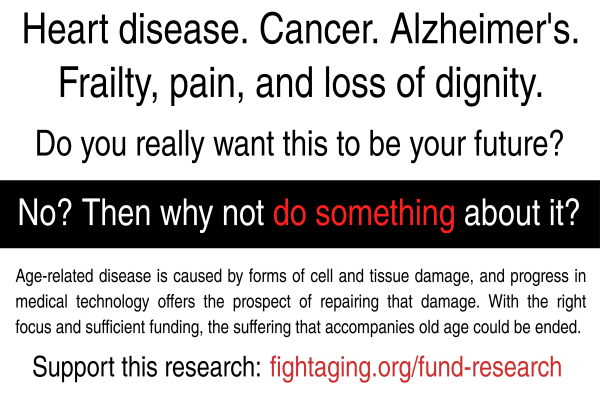Naked Mole Rats Retain Neural Plasticity Across a Life Span
Two of the many topics of interest found in the study of longevity are (a) the long-lived naked mole rat and (b) the processes by which the mammalian brain generates new neurons and connections to maintain itself. Today I'll point out a paper that sits in the overlap between these two fields of study, in which researchers show that naked mole rats retain a very youthful-looking degree of neural plasticity, as well as other measures associated with younger, developing brains, all the way across their lengthy life spans.
The research community has put a great deal of time and money into the study of naked mole rat biology, and especially in recent years. This is an unusual species: very long-lived for its size, one of the very few eusocial higher animals, exhibiting negligible senescence over its considerable life span, and apparently immune to cancer. Given today's research priorities, with much more of a focus placed upon cancer than upon aging, it is the cancer resistance that really pulls in the funding and interest. Still, investigation of the underlying reasons for the exceptional longevity and healthspan of this species continues to produce a growing river of papers.
The brain changes over time, the connections between neurons altering in response to environment and circumstances. This remodeling occurs much more rapidly in youth than in adulthood, and further diminishes with age for reasons that are much debated: you can look at the state of research for any neurodegenerative condition to see the range of theorizing and discussion, coupled with the sheer amount of work left to be done in order to explore the full complexity of neural biochemistry. It is thought that some of the characteristic changes observed in the brain with age are a sort of compensatory remodeling, attempts to cope with rising levels of damage and dysfunction. It is more widely agreed that artificially increasing adult levels of neural plasticity could form the basis for therapies to partially alleviate at least some of the consequences of age-related neurodegeneration.
Here researchers argue that naked mole rats evolved a resilience to age-related degeneration in the brain by greatly extending the period over which the brain is developing. Processes that have diminished by adulthood in other mammals instead continue apace in naked mole rats. The argument ties in nicely with other aspects of the biochemistry of this species wherein it looks very much as though oxygen-poor underground environments were the evolutionary driver for changes that incidentally also happen to produce extended longevity with little degeneration until close to the end of life.
Protracted brain development in a rodent model of extreme longevity
In this study, we show that brain maturation, as indicated by molecular, morphological, and electrophysiological features, is extremely protracted in naked mole-rats. Embryonic and early postnatal (pre-weaning) neurogenesis apparently provides adequate neuronal populations for life-long brain function in naked mole-rats, since cell proliferation rates as measured by marker 5-ethynyl-2'-deoxyuridine (EdU) incorporation at postnatal dates, are not higher than in mice. This is also supported by the finding that markers of apoptosis are not elevated in the postnatal naked mole rat brain. Instead, we observed a prolonged retention of "immature" neuronal features including expression of PSA-NCAM, providing scaffolding for neurite outgrowth, delayed morphogenic maturation of hippocampal neurons, and incomplete synapse patterning as naked mole rats age. Therefore, we propose that while developmental neurogenesis provides adequate neuronal populations for adult brain functions, postnatal maturation of those neurons is greatly extended to provide much needed cellular dynamics to prevent structural damage and cell senescence in a low oxygen environment.We found lower amounts of neurogenesis in the adult naked mole rat, as compared to the mouse. This suggests that the bulk of neurons is produced during fetal development, and remains physiologically active until senescence. In common laboratory rodents, particularly mice, neuronal apoptosis peaks during the neonatal period to prune redundancy during brain circuit formation. In our sample cohort, we did not find significant cleaved caspase-3 immunoreactivity during the period ranging from 7 days to 10 years postnatally, fuelling the provocative idea that cell production is tightly tuned by metabolic and/or oxygen restrictions, likely limiting otherwise metabolically demanding processes of cell elimination. Alternatively, some neuronal cohorts might not reach full maturity even during the extended life-span of naked mole rats, thus precluding their incentive to initiate apoptotic programs. Instead, we find elevated cleaved caspase-3 levels in the 21-year-old naked mole rat, reflecting the age-related increase of apoptosis found in common laboratory rodents.
In sum, we show that naked mole rats, a "treasure trove" for translational neurobiology, exhibit a very prolonged period of postnatal brain development consistent with a neotenous evolutionary mechanism. Protracted brain development may allow naked mole rat brain to cope with extremely low levels of O2 in their crowded subterranean burrows. Extended development may be accompanied by enhanced brain plasticity to preclude neurodegenerative processes during their extraordinary life-span. Thus, understanding the molecular basis of these processes warrants future research particularly aimed at expanding our tool kit to fight neurodegeneration and age-associated dementia.
The same question applies to naked mole rats as to salamanders and zebrafish: is it really practical from cost/benefit perspective to mine their biochemistry for the improvements we'd like to see in our own? That question can't be answered without doing most of the work, and the answer may be different in each case. Perhaps a useful therapy can result and is well within present medical capabilities if we only knew more. Equally perhaps integrating what is learned would require such sweeping, difficult changes to human biochemistry that we'd be far better off focusing on other types of therapy. We shall see.

